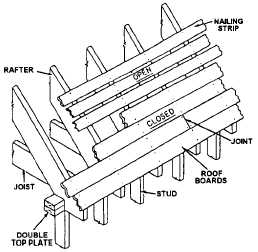CHAPTER 3
ROOF CONSTRUCTION AND TRIM CARPENTRY
The previous chapters have dealt with framing
wood structures, including joists, studs, rafters, and
other structural members. These constitute “rough
carpentry” and are the main supports of a wood-frame
structure. (Subflooring and wall and roof sheathing
strengthen and brace the frame.)
The remaining work on the structure involves
installing the nonstructural members. This work,
referred to as “finish carpentry,” includes installing the
roof covering, door and window frames, and the doors
and windows themselves. Some nonstructural members
are purely ornamental, such as casings on doors and
windows, and the moldings on cornices and inside
walls. Instillation of purely ornamental members is
known as trim carpentry.
Finish carpentry is divided into exterior and interior
finish. Exterior finish material consist of roof sheathing,
exterior trim, roof coverings, outside wall covering, and
exterior doors and windows. Exterior finish materials
are installed after the rough carpentry has been
completed. Examples of interior finish materials include
all coverings applied to the rough walls, ceilings, and
floors. We will cover these topics in a later chapter.
In this chapter, we’ll cover the exterior finishing of
roofs. In the next chapter, we’ll examine the exterior
finishing of walls.
ROOF SHEATHING
LUMBER
Roof sheathing boards are generally No. 3 common
or better. These are typically softwoods, such as Doughs
fir, redwood, hemlock, western larch, fir, and spruce. If
you’re covering the roof with asphalt shingles, you
should use only thoroughly seasoned wood for the
sheating. Unseasoned wood will dry and shrink which
may cause the shingles to buckle or lift along the full
length of the sheathing board.
Nominal 1-inch boards are used for both flat and
pitched roofs. Where flat roofs are to be used for a deck
or a balcony, thicker sheathing boards are required.
Board roof sheathing, like board wall sheathing and
subflooring, can be laid either horizontally or
diagonally. Horizontal board sheathing may be closed
(laid with no space between the courses) or open (laid
with space between the courses). In areas subject to
wind-driven snow, a solid roof deck is recommended.
Installation
Roof boards used for sheathing under materials
requiring solid, continuous support must be laid closed.
This includes such applications as asphalt shingles,
composition roofing, and sheet-metal roofing. Closed
roof sheathing can also be used for wood shingles. The
boards are nominal 1 inch by 8 inches and may be
square-edged, dressed and matched, shiplapped, or
tongue and groove. Figure 3-1 shows the installation of
both closed and open lumber roof sheathing.
LEARNING OBJECTIVE: Upon completing
this section, you should be able to identify
various types of roof sheathing and describe
their installation requirements.
Roof sheathing covers the rafters or roof joists. The
roof sheathing is a structural element and, therefore, part
of the framing. Sheathing provides a nailing base for the
finish roof covering and gives rigidity and strength to
the roof framing. Lumber and plywood roof sheathing
are the most commonly used materials for pitched roofs.
Plank or laminated roof decking is sometimes used in
structures with exposed ceilings. Manufactured wood
fiber roof decking is also adaptable to exposed ceiling
applications.
Figure 3-1.-Closed and open roof sheathing.
3-1


